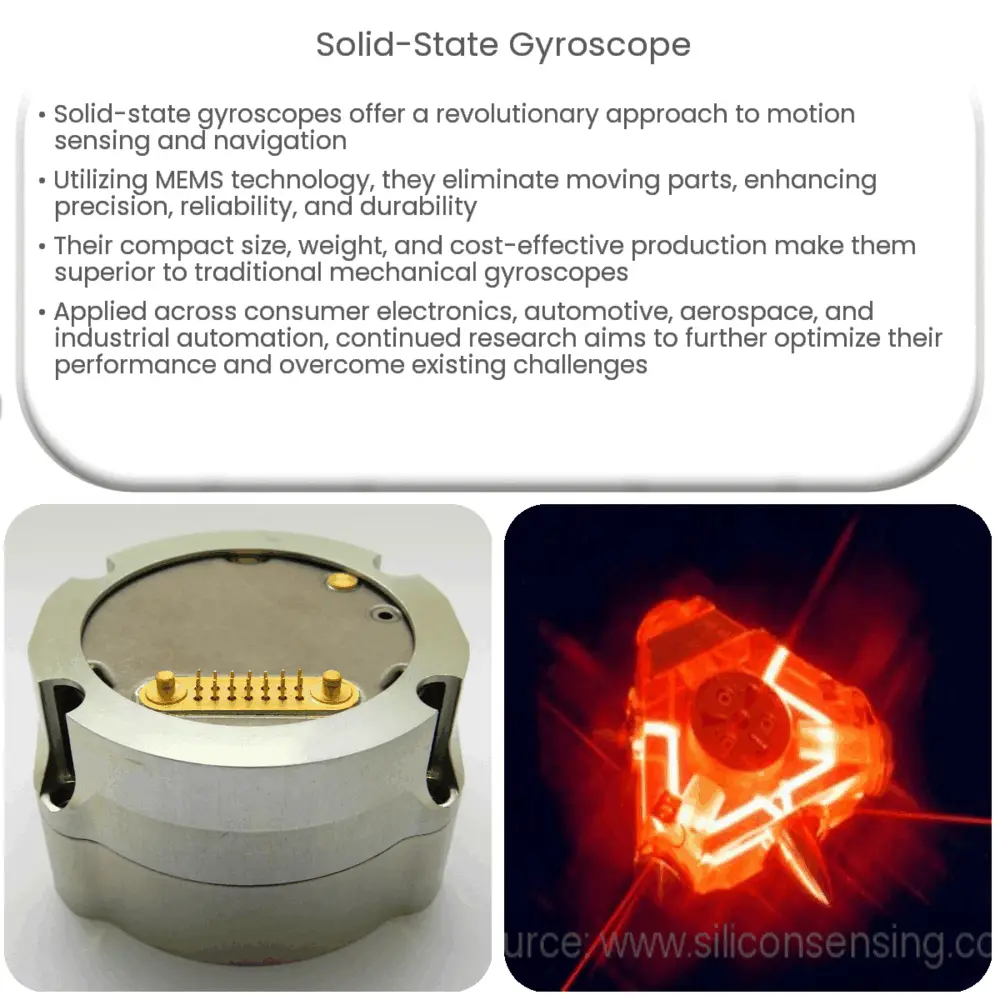Solid-state gyroscopes are advanced motion sensors that offer improved precision, reliability, and compactness, revolutionizing various industries.

Solid-State Gyroscope: The Future of Motion Sensing
Introduction
The solid-state gyroscope is a cutting-edge technology that promises to revolutionize motion sensing, navigation, and control systems across industries. These devices offer significant advantages over traditional mechanical gyroscopes, including improved performance, reliability, and cost-efficiency. In this article, we will explore the fundamentals of solid-state gyroscopes, their applications, and the impact they could have on the future of various industries.
What is a Solid-State Gyroscope?
A gyroscope is a device used to measure angular velocity or maintain orientation based on the principles of angular momentum conservation. Traditional mechanical gyroscopes consist of a spinning wheel or disc mounted on a gimbal, which allows the wheel to rotate freely in any direction. The rotation of the wheel creates angular momentum, enabling the gyroscope to maintain its orientation even when subjected to external forces.
Solid-state gyroscopes, on the other hand, do not rely on moving parts. Instead, they employ microelectromechanical systems (MEMS) technology, which leverages the unique properties of materials at the microscale to create miniature sensors and actuators. Solid-state gyroscopes typically use a vibrating structure, such as a tuning fork or a resonant ring, to measure angular velocity. The Coriolis effect causes a perpendicular force to act on the vibrating structure when the device rotates, resulting in a measurable change in the vibration pattern.
Advantages of Solid-State Gyroscopes
There are several benefits associated with solid-state gyroscopes that make them an attractive alternative to traditional mechanical designs:
- Higher precision and sensitivity: MEMS technology enables the fabrication of highly sensitive and accurate sensors, allowing solid-state gyroscopes to deliver superior performance compared to their mechanical counterparts.
- Greater reliability and durability: The absence of moving parts in solid-state gyroscopes significantly reduces wear and tear, resulting in longer device lifespans and increased resistance to shock and vibration.
- Compact size and weight: Solid-state gyroscopes can be made much smaller and lighter than mechanical designs, making them ideal for applications where space and weight constraints are critical.
- Cost-effective production: The fabrication process for MEMS devices is compatible with conventional semiconductor manufacturing techniques, allowing for cost-effective mass production of solid-state gyroscopes.
Applications of Solid-State Gyroscopes
Solid-state gyroscopes have a wide range of applications, thanks to their unique combination of high performance, reliability, and compact form factor. Some of these applications include:
- Consumer electronics: Smartphones, tablets, and wearables often integrate solid-state gyroscopes to enhance user interfaces, gaming experiences, and navigation capabilities.
- Automotive: Advanced driver assistance systems (ADAS) and autonomous vehicles rely on solid-state gyroscopes for accurate motion sensing and navigation data.
- Aerospace and defense: Solid-state gyroscopes are used in guidance systems for aircraft, missiles, and satellites, as well as in inertial navigation systems (INS) and attitude and heading reference systems (AHRS).
- Industrial automation: Robots and autonomous machinery employ solid-state gyroscopes for precise motion control and stabilization.
Challenges and Future Developments
Despite their numerous advantages, solid-state gyroscopes still face some challenges that need to be addressed. One of the main issues is their susceptibility to environmental factors such as temperature fluctuations, which can impact the accuracy and stability of the measurements. Additionally, solid-state gyroscopes can exhibit drift, a gradual deviation in the output signal over time, which may require periodic calibration or compensation algorithms to maintain accuracy.
Research is underway to develop new materials, designs, and fabrication techniques to enhance the performance and reliability of solid-state gyroscopes further. For example, researchers are exploring the potential of optical gyroscopes that use the Sagnac effect in a ring laser or fiber-optic coil, which can offer improved sensitivity and stability compared to MEMS-based devices. Additionally, advancements in nanotechnology and materials science are paving the way for novel solid-state gyroscope designs that could provide even higher precision and reduced susceptibility to environmental factors.
Conclusion
Solid-state gyroscopes represent a significant leap forward in motion sensing and navigation technology. Their numerous advantages over traditional mechanical gyroscopes, such as improved performance, reliability, compact size, and cost-efficiency, make them an attractive choice for a wide range of applications across various industries. As research and development efforts continue to address current limitations and explore new possibilities, solid-state gyroscopes are poised to become an integral part of the next generation of technological advancements in consumer electronics, automotive, aerospace, defense, and industrial automation sectors.
References
- J. M. Kahn, K. S. J. Pister, and S. Hollar, “Next generation MEMS-based solid-state gyroscopes,” Proceedings of the IEEE, vol. 99, no. 2, pp. 194-206, Feb. 2011.
- D. Senkal, M. A. Eshraghi, and A. Shkel, “Advances in solid-state gyroscopes: A review of technology and applications,” Sensors, vol. 19, no. 24, p. 5473, Dec. 2019.
- N. C. Luhmann Jr., D. A. Markov, and C. W. de Silva, MEMS and Nanotechnology-Based Sensors and Devices for Communications, Medical, and Aerospace Applications. Boca Raton, FL: CRC Press, 2008.

